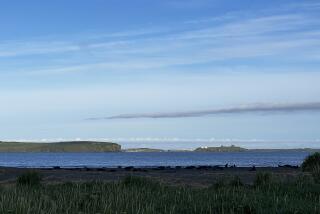Alaska Project Tries to Grow Forests on Barren Islands : Trees: Residents hope hardy species will provide scenic beauty and windbreaks. Some scientists worry about upsetting the environment.
ANCHORAGE — In an age of shrinking forests, people on the Bering Sea island of St. George are trying to extend the forest’s frontier, planting thousands of trees in a place where even one is a novelty.
The trees’ chances of survival are uncertain, and some environmentalists fear that introducing them to a treeless area may harm existing species.
But scientists backing the project disagree, as does Anthony Merculief, president of the native corporation St. George Tanaq, who suggested the idea to the Alaska Division of Forestry.
“I’d just like to see trees,” he said. “A lot of places have trees. Why shouldn’t we have a few of our own? I can’t imagine anybody not liking trees.”
Recently, officials with the state agency and the U.S. Forest Service planted about 2,500 Sitka spruce, Chinese larch and lodgepole pine seedlings on land owned by the corporation on St. George, one of the Pribilof Islands, about 225 miles north of the Aleutians. (An additional thousand trees were left with villagers to plant.)
The officials were joined by St. George’s 33 schoolchildren, who, along with their successors, are charged with taking care of the trees and sending progress reports to state foresters.
“Many of them have never seen trees before, although they see a lot of it on TV,” said Beverly Mierzejek, who teaches kindergarten and first grade in the village of about 140 people.
“They’re looking forward to seeing them grow. They say: ‘Well, I’m going to be an old man before this thing’s grown up. Our grandkids will get to play on them and we can’t.’ ”
Residents hope the trees will provide scenic beauty and also act as windbreaks around homes. State and federal researchers plan to set up plots to study trees at high latitudes.
Each child was given one tree to plant at home. A few hundred seedlings will be planted around the town, and about 2,000 are marked for Garden Cove, a recreation area on the south side of the island that includes a rare freshwater stream.
About 100 more will be planted near an old Russian Orthodox shrine, and another hundred or so will be planted at the site of an early settlement, said Bill Beebe, who is spearheading the project for the state forestry division.
“We can’t guarantee they’re going to have a big beautiful forest, but we think most of the trees will do pretty well,” Beebe said. “We were careful to pick the species with the best chances for survival.”
The Forest Service is contributing about $5,000 to the project from its urban forestry program. The state paid about $500 for 2,000 larch trees; the Forest Service paid about $90 for 500 pines; and the rest of the trees were free, Beebe said.
The species were selected for hardiness in subarctic climates by John Alden, a tree geneticist at the Forest Service’s Institute of Northern Forestry in Fairbanks, Alaska.
The St. George project may be the largest in a string of efforts to plant trees in Alaska’s Aleutian and Pribilof islands, Alden said.
As early as 1805, Russian fur traders tried planting a forest at what is now Dutch Harbor in the Aleutians so they could have wood for ships, fuel and homes, he said. About 24 trees were standing there in 1830--four survive now.
During World War II, the Army planted thousands of seedlings on the land of Adak in the Aleutians to boost morale. The “forest” now has 33 trees, none taller than 17 feet.
Several years ago, Oregon-based ReTree International, a nonprofit group dedicated to reforestation, planted an unknown number of trees on St. Paul, another of the Pribilof Islands. Many were believed smothered by snow or blown away.
St. George has one spruce tree, although residents say it’s more of a shrub. Planted by an Orthodox priest in the churchyard a dozen years ago, it stands stunted and bent, but alive.
Alden estimates no more than 10% of the trees planted over the years in the Aleutian Islands have survived the cold temperatures and fierce wind.
The Pribilofs, home to one of the largest sea bird and seal concentrations in the Northern Hemisphere, have a mean monthly growing-season temperature of 47 degrees, Alden said. Trees generally need a mean of 50 degrees to grow straight, he said.
Organizers say these trees might fare better than most, however, partly because of the selected species and partly because of the care they will get.
Shelters will be constructed over the trees during their early years, and some will be planted under tar paper to keep native grasses from crowding out seedlings.
Arctic fox may try to eat the seedlings, and reindeer may trample them, but it’s too soon to know whether to take preventive measures, Beebe said.
“They may have setbacks for a few years, and many will gradually recover,” Alden said. “They won’t reach great height.”
Beebe has asked the Alaska Center for the Environment for comment on the program. The center’s Cliff Ames doesn’t know if the center will object to the plan and said it may not have much influence anyway because the trees will be planted on private land.
More to Read
Sign up for Essential California
The most important California stories and recommendations in your inbox every morning.
You may occasionally receive promotional content from the Los Angeles Times.









